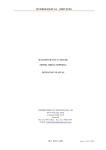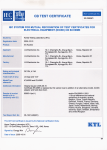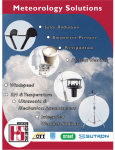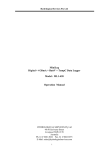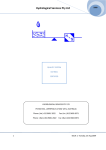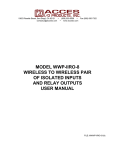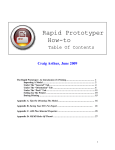Download MiniLog Operation Manual - Hydrological Services America
Transcript
Hydrological Services Pty Ltd WIRELESS LEVEL TRANSMITTER MODEL WLT420 OPERATING MANUAL HYDROLOGICAL SERVICES Pty Ltd 48-50 Scrivener Street Liverpool NSW 2170 Australia Ph. 61 2 9601 2022 Fax. 61 2 9602 6971 E-Mail: [email protected] 1 Hydrological Services Pty Ltd TABLE OF CONTENTS 1. Product Overview .............................................................................. 3 2. Installation .......................................................................................... 4 2.1 2.2 2.3 3. 3.1 3.2 3.3 4. 4.1 Hardware Connections ....................................................................................... 4 Antenna Mounting............................................................................................... 7 Power Supply ....................................................................................................... 7 Operation ............................................................................................ 8 Transmitter LED ................................................................................................. 8 LCD Navigation ................................................................................................... 8 Displaying Water Volume ................................................................................... 10 Specification ....................................................................................... 11 Hardware Specification....................................................................................... 11 Appendix A Connecting a WL1200W Transducer ...................................... 12 Appendix B Creating the Level to Volume Formula.................................... 13 Wireless Level Transmitter © Copyright WLT420 Page-2 Issue 1.30 19 Nov, 2013 Hydrological Services Pty Ltd 1. Product Overview The Hydrological Services Wireless Level Transmitter WLT420 has been designed using surface mount technology to provide a very small, ultra low power and reliable wireless 4 to 20mA and a single digital I/O transmitter / receiver pair that can be used in harsh environments for extended periods. The Wireless Level Transmitter’s primary purpose is to periodically measure a 4-20mA transducer and monitor the event data from a digital input, and to wirelessly transmit the measurement to a different location and reproduce the 4-20mA signal and the digital output. This is done with a very low power consumption (typically 150uA while asleep) which makes it ideal for remote sites where long battery life is important. The receiver also has an LCD to display the water level, tip count, current measurement, signal strength and other parameters. TBRG (Digital I/P) Wireless Level Transmitter 1km range + Wireless Level Receiver 4-20mA and Digital output 12V Battery + 4-20mA Pressure Transducer - 12V Battery Wireless Level Transmitter © Copyright WLT420 Page-3 Issue 1.30 19 Nov, 2013 Hydrological Services Pty Ltd 2. Installation 2.1 Hardware Connections The Wireless Level Transmitter periodically switches the battery voltage to the transducer for the warm up time (preset on the DIP switches) and then measures the 4-20mA current. It also continuously monitors the digital input for a contact closure, and passes on the accumulated count when a transmission occurs The terminals are screwless, simply push the wire into terminal hole – you may need to depress the orange release lever if fine wire is used. This lever is also used to remove the wire. Status LED Transducer + Battery + Battery - Transducer (4-20mA I/P) Digital I/P + Digital I/P – (0V) Configuration DIP Switches Freq 0 1 2 3 4 5 6 7 1: 01010101 2: 00110011 3: 00001111 4: 0=AUS 1=US TxInt cnt 1 15 5: 0 1 0 6: 0 0 1 60 1 1 WarmUp 2 5 10 15 7: 0 1 0 1 8: 0 0 1 1 Aerial Wireless Level Transmitter 0=off 1 2 3 4 5 6 7 8 1=on DIP Switches 1,2,3 set the transmission frequency and DIP switch 4 sets the frequency band for : USA and Australia. 0 = 905.5MHz 917.5MHz 1 = 906.5MHz 918.5MHz 2 = 907.5MHz 919.5MHz 3 = 908.5MHz 920.5MHz 4 = 909.5MHz 921.5MHz 5 = 910.8MHz 922.5MHz 6 = 911.9MHz 923.5MHz 7 = 912.5MHz 924.5MHz DIP Switches 5 and 6 set the transmission interval (in minutes) to continuous, 1 min, 15 min and 60 min. DIP Switches 7 and 8 set the transducer warm up (in seconds) to 2 secs, 5 secs, 10 secs and 15 secs. Wireless Level Transmitter © Copyright WLT420 Page-4 Issue 1.30 19 Nov, 2013 Hydrological Services Pty Ltd Transducer Power Off On On Warm Up 2,5,10,15 Secs Warm Up 2,5,10,15 Secs Sample 1 Sec Sample 1 Sec TxInt Transmission Interval 0,1,15,60 Mins (continuous = 0 mins) Transmission What are the WarmUp and TxInt periods ? The transducer is powered on during the Warm Up period and then a sample is taken lasting 1 second. (256 x 12 bit samples are taken during this 1 second period and averaged) Power is removed from the transducer, the data is transmitted and the LED flashed. The Wireless Level Transmitter then goes to sleep during the Transmission Interval to conserve the battery power. The cycle then repeats at the end of the transmission period of 1, 15 or 60 mins. **** NOTE **** : When the transmission period is set to continuous, the cycle repeats without going to sleep – and therefore the transmitter never enters the low power mode ! Wireless Level Transmitter © Copyright WLT420 Page-5 Issue 1.30 19 Nov, 2013 Hydrological Services Pty Ltd The Wireless Level Receiver has an optically isolated 4-20mA output that is powered by the external 4-20mA power. 4-20mA output + Battery + Battery – (0v) 4-20mA output (NOTE : The 4-20mA circuit has no electrical connection to the battery side of the circuit) Digital O/P + Digital O/P – (0v) Configuration DIP Switches Aerial Wireless Level Receiver 0=off Freq 0 1 2 3 4 5 6 7 1: 01010101 2: 00110011 3: 00001111 4: 0=AUS 1=US DIP Switches 1,2,3 set the transmission frequency and DIP switch 4 sets the frequency band for : USA and Australia. 0 = 905.5MHz 917.5MHz 1 = 906.5MHz 918.5MHz 2 = 907.5MHz 919.5MHz 3 = 908.5MHz 920.5MHz 4 = 909.5MHz 921.5MHz 5 = 910.8MHz 922.5MHz 6 = 911.9MHz 923.5MHz 7 = 912.5MHz 924.5MHz 1=on 1 2 3 4 Switched Power Batt + Batt 4-20mA output + + Measure - + Battery Wireless Level Transmitter © Copyright 4-20mA output Digital o/p + Digital o/p - To Logger 0V Wireless Level Receiver (Separate batteries are shown to indicate the isolation between the 4-20mA and the rest of the circuit – the same battery may be used if desired.) WLT420 Page-6 0V + Battery Issue 1.30 19 Nov, 2013 Hydrological Services Pty Ltd 2.2 Antenna Mounting Both the transmitter and receiver are supplied with a ground plane independent antenna that have 1.5dB gain. (The mounting thread of the antenna is connected to the battery –ve input.) The antenna is mounted by : Hold the antenna coax cable firmly and unscrew the antenna body. Remove the nut and washer from the antenna body and put onto the coax cable. Drill a 10mm mounting hole. Insert the coax cable through the mount hole – from the inside of the enclosure. Screw the antenna body back onto the coax cable. Insert the antenna into the mounting hole and slide the washer and nut onto the antenna body and tighten the nut. 2.3 Power Supply The Wireless Level Transmitter requires a 12V power source, such as a 7Ah lead acid battery. The transmitter has 2 basic states, sleep and warm up. Tx Mode Sleep Warm Up Current Consumption 0.15A 10mA + measured 4-20mA The Wireless Level Receiver also requires a 12V power source, such as a 7Ah lead acid battery. The receiver has 4 basic states. Rx Mode Sleep (with no 4-20mA power) Sleep (with 4-20mA power) LCD on (backlight off) LCD on (backlight on) Wireless Level Transmitter © Copyright Current Consumption 0.1mA 0.6mA 20mA 75mA WLT420 Page-7 Issue 1.30 19 Nov, 2013 Hydrological Services Pty Ltd 3. Operation DIP Switches 1 to 4 on the transmitter and receiver MUST be set the same, so that both units are set to the same frequency. If multiple units are required in the same vicinity, then set them to a different frequency. Note that the units use a license free band – however, these bands are different in Australia and the USA, so make sure DIP switch 4 is set appropriately. The transmitter sends the 4-20mA current measured, tip count, switch settings, battery voltage and the software revision. This information is all displayed on the receiver LCD. When the transmitter is set to continuous transmit mode, the receiver LCD recognises this and stays on permanently. This mode is useful when testing the WLT420. When the transmitter is set to transmit every 1min, 15 mins or 60 mins then the receiver will automatically go to sleep, and then automatically wake up the RF circuitry ready to receive the next expected message – the receiver will stay awake until the message is received. When a message is received the status LED on the WLT420R Receiver will flash. 3.1 Transmitter LED The transmitter LED indicates what state the transmitter is in. LED Flashes every 2 secs Flashes fast On Steady 3.2 Description Transmitter is asleep Transducer has power applied – in warm up mode Measuring transducer 4-20mA for 1 sec, then transmits result LCD Navigation Press either button to wake up the receiver for 30 secs. The backlighting will also come on for 5 secs. The display will be continually updated as new data is received. Press the scroll button to step through the most commonly used menu items. Press the select button for 5 seconds to step to special menus as shown. The “WaterLvl” menu uses the received 4-20mA value in conjunction with the preset “Range” to calculate the water level. The “Tip Count” menu displays the accumulated digital input counts – typically from a TBRG. Use the “Set Level” menu to set the measured water level. This will automatically calculate an appropriate offset and add it to the measured 4-20mA level. Scroll to the “Offset” menu to view this calculated offset. The Offset may be zeroed by pressing the scroll button for 5 secs. The “Range” menu allows the transducer range to be set. The “Last Rx” menu shows the last time an RF message was received in hrs:mins:secs. This will allow you to see if messages are being received correctly. The “TxIntvl” and “Warm Up” menus show you the present positions of the WLT420 transmitter DIP switches. The “SignalStr” menu indicates the signal strength from 0 to 7, with 7 being the strongest signal – this can be helpful when positioning or aligning antenna’s. Wireless Level Transmitter © Copyright WLT420 Page-8 Issue 1.30 19 Nov, 2013 Hydrological Services Pty Ltd NOTE : No text on arrow => Press Scroll button Sel 5 sec => Press Select button for 5 secs Water Lvl 1.375m Sel 5 sec Tip Count 592 Skip if VolDsply Disabled Volume 3716.3 Ml Sel 5 sec Set Level 1.200m Select Offset -0.175m Sel 5 sec VolDsply Enabled Select Poly-0 0003.2 Select Rem BatV 12.9V 4-20mA 4.923mA Last Rx 00:00:05 SignalStr 4 (0-7) Wireless Level Transmitter © Copyright Zero Offset Edit Volume Display Enabled / Disabled Edit Polynomial Term 0 : : Poly-4 1234.5 My BattV 12.6V Edit Set Level Sel 5 sec Sel 5 sec Sel 5 sec Sel 5 sec Select Edit Polynomial Term 4 My S/W Rev 1.00 Rem S/W Rev 1.00 Range 10m Select Edit Range TxIntval 1 min WarmUp 5 Secs WLT420 Page-9 Issue 1.30 19 Nov, 2013 Hydrological Services Pty Ltd 3.3 Displaying Water Volume The WLT420 has the facility to display the water volume (of a reservoir) as a function of the water level. See Appendix B for details on how to derive the appropriate equation and hence the terms of the 4th order polynomial Poly0 thru to Poly4. The formula generated in the example is : Water Volume = 0.8065 x4 - 18.957 x3 + 165.76 x2 - 19.588 x + 0.000 (where x is the water depth in metres) For this example, the polynomial terms entered into the WLT420 are as follows : (Please note the sign of each term !!!!!) Poly0 = 0.000 Poly1 = - 19.588 Poly2 = 165.760 Poly3 = - 18.957 Poly4 = 0.8065 ( term for x0, which is the intercept ) ( term for x1, which is just x ) ( term for x2 ) ( term for x3 ) ( term for x4 ) The Volume display option must first be enabled. (Examine the LCD navigation chart on the previous page.) Press the Scroll button and step to the “WaterLvl” menu. Press and hold the Select button for 5 secs until the “SetLevel” menu appears. Press the Scroll button twice and advance to the “VolDsply”. Press the Select button to start the “Disabled” flashing. Press the Scroll button to select “Enabled” flashing. Press the Select button to stop the flashing. Press Scroll button to save the VolDsply enabled feature. Press the Scroll button to advance to the “Volume” display. Press and hold the Select button for 5 seconds until the “Poly0” menu appears. Press the Select / Scroll / Select buttons to advance each digit of Poly0. Press the Scroll button to step to “Poly1” Repeat the previous steps to set Poly1, Poly2, Poly3 and Poly4. Press Scroll to step back to the “Volume” display. The water volume should now be displayed. By using the “Set Level” menu item, you can preset various levels and hence check the Water Volume. As the water level now changes between 0.000m and 10.000m the water volume of the reservoir will be displayed. The water volume created from this 4th order polynomial is not exact – but it is a very good approximation. Wireless Level Transmitter © Copyright WLT420 Page-10 Issue 1.30 19 Nov, 2013 Hydrological Services Pty Ltd 4. Specification 4.1 Hardware Specification Supply Voltage Typically 12V dc (8Vdc min to 20Vdc absolute max) Transmitter Inputs 4-20mA Input (12 bit resolution : 256 samples over 1 sec) Digital Input (typically connects to a TBRG) Receiver Outputs 4-20mA Output (16 bit resolution) Digital Output (Open collector transistor) Indicators WLT420T Transmitter - Status LED indicator WLT420R Receiver – Status LED + 8 char x 2 line LCD Displays Water Level, Tip Count, Volume, Batt Voltage, … Controls WLT420R Receiver – Scroll + Select pushbuttons Connections Screwless Terminals Radio Frequency US AUS Transmit Power 10mW Range 1km (0.62 miles) line of sight (with standard CD1160 (1.5dBi) ground independent antenna) (3km has been obtained with higher gain 11dBi yagi antennas) Dimensions 125mm x 80mm x 57mm (L x W x D) Weight WLT420T Transmitter with aerial 600 grams WLT420R Receiver with aerial 620 grams Environmental -40C to + 70C at 95% RH Non Condensing Aluminium waterproof housing IP67 Wireless Level Transmitter © Copyright 905.5 to 912.5MHz 917.5 to 924.5MHz WLT420 Page-11 Issue 1.30 19 Nov, 2013 Hydrological Services Pty Ltd Appendix A Connecting a WL1200W Transducer Brown Green Blue Wireless Level Transmitter © Copyright WLT420 Page-12 Transducer + Transducer Earth Screen Issue 1.30 19 Nov, 2013 Hydrological Services Pty Ltd Appendix B Creating the Level to Volume Formula The WLT420 has the facility to display the water volume (of a reservoir) as a function of the water level. The function implemented is a 4th order polynomial. This appendix shows how to generate the formula from a “level : volume” data table. After a site survey, a table of data equating water level (in metres) to water volume (in mega-litres) should be entered into an Excel spreadsheet as shown (This procedure assumes the water volume is always in mega-litres.) Select the data, then click on the “Chart Wizard” or select the menu item “Insert – Chart”. Click on XY (Scatter) and click finish. This will automatically create a graph of points relating water level (x axis) to the water volume (y-axis). Position and size spreadsheet page. Wireless Level Transmitter © Copyright the graph on the WLT420 Page-13 Issue 1.30 19 Nov, 2013 Hydrological Services Pty Ltd Click on one of the graph points, then right click and select “Add trendline…” Click on Polynomial and increase “Order” to 4 (to create a 4th order polynomial) Click on the “Options” tab. Select “Set intercept =” and then enter the water volume when the water level is 0.00m Select “Display equation on chart” Click OK Wireless Level Transmitter © Copyright WLT420 Page-14 Issue 1.30 19 Nov, 2013 Hydrological Services Pty Ltd The line drawn on the chart is the 4th order polynomial. You should get a good idea of how well the formula fits the tabled data. The formula generated in this case is : Water Volume = 0.8065 x4 - 18.957 x3 + 165.76 x2 - 19.588 x + 0.000 (where x is the water depth in metres) For this example, the polynomial terms entered into the WLT420 are as follows : (Please note the sign of each term !!!!!) Poly0 = 0.000 Poly1 = - 19.588 Poly2 = 165.760 Poly3 = - 18.957 Poly4 = 0.8065 ( term for x0, which is the intercept ) ( term for x1, which is just x ) ( term for x2 ) ( term for x3 ) ( term for x4 ) As the water level now changes between 0.000m and 10.000m the water volume of the reservoir will be displayed. The water volume created from this 4th order polynomial is not exact – but it is a very good approximation. Wireless Level Transmitter © Copyright WLT420 Page-15 Issue 1.30 19 Nov, 2013
















